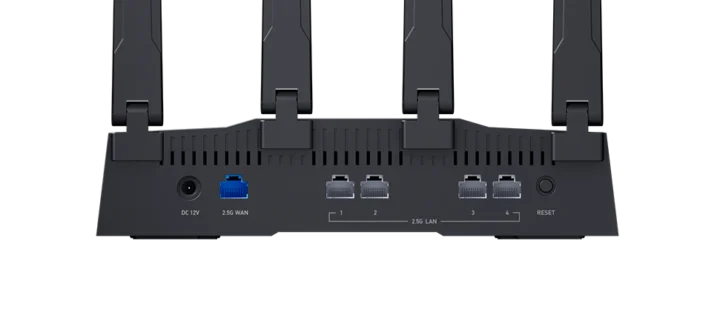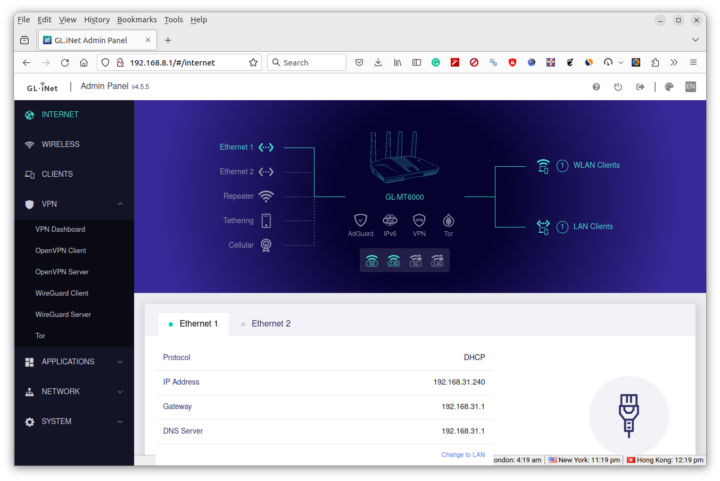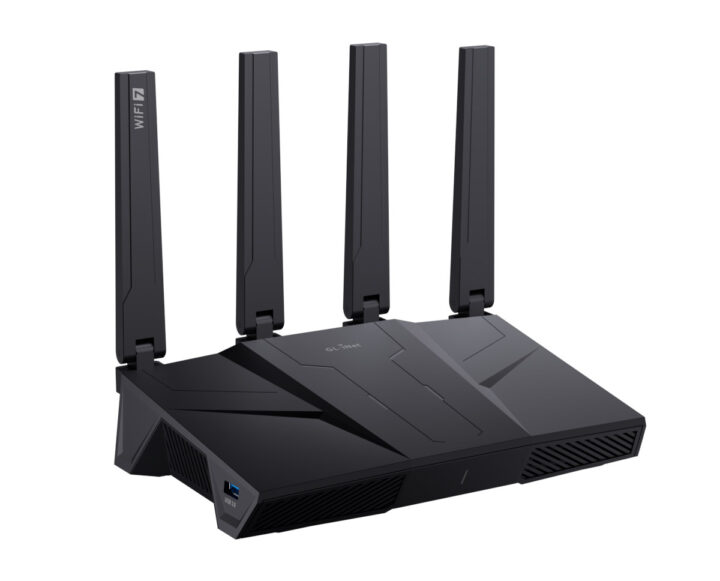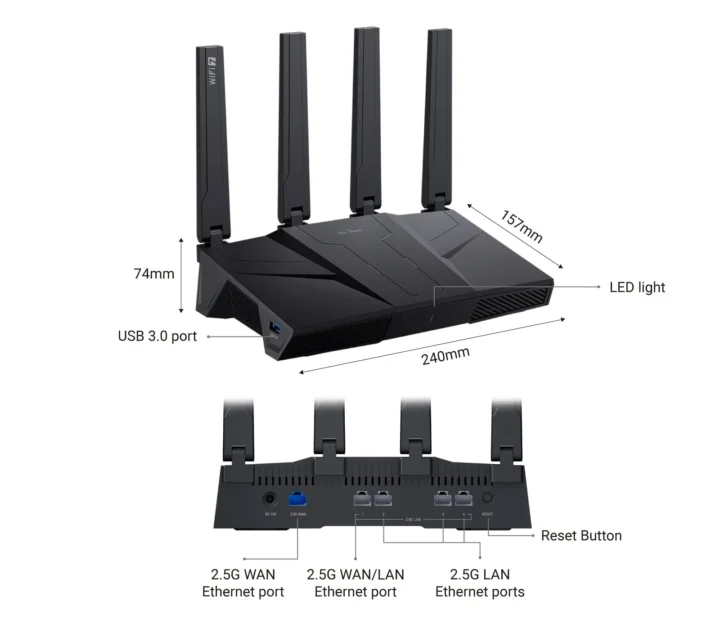The GL.iNet Flint 3 (codenamed GL-BE9300) is an affordable tri-band WiFi 7 BE9300 router with five 2.5GbE RJ45 ports supporting 10Gbps aggregation, and now available for pre-order for $119 to $159. It follows the lower-end GL.iNet Slate 7 (GL-BE3600) WiFi 7 dual-band travel router introduced a few months ago.
The tri-band WiFi 7 router is powered by a 1.5 GHz quad-core Qualcomm processor coupled with 1GB RAM and 8GB eMMC flash for the OS, features a USB 3.0 port for smartphone tethering or cellular dongle, and supports up to 680 Mbps VPN throughput using WireGuard or OpenVPN. Other features include AdGuard Home, failover, load balancing, and more.
GL.iNet Flint 3 specifications:
- CPU – Qualcomm quad-core @1.5 GHz; unamed, but likely Qualcomm IPQ5332
- Memory – 1 GB DDR4
- Storage – 8 GB eMMC flash
- Networking
- WiFi 7
- Protocol – IEEE 802.11a/b/g/n/ac/ax/be
- Wi-Fi Speed – 688Mbps (2.4GHz), 2882Mbps (5GHz), 5765Mbps (6GHz)
- 4x foldable external Wi-Fi antennas
- Ethernet
- 1x 2.5 Gbps WAN Ethernet port
- 1x 2.5 Gbps WAN/LAN Ethernet port
- 3x 2.5 Gbps LAN Ethernet ports
- Internet connection methods – Ethernet, Repeater, Tethering (USB), or Cellular (USB) with support for failover and load balancing
- VPN – Up to 680 Mbps on both WireGuard and OpenVPN-DCO; note: not quite the 900 Mbps WireGuard throughput tested in the Flint 2.
- WiFi 7
- USB – 1x USB 3.0 port
- Misc
- Reset button
- Dual-color LED
- Power Supply – 12V/4A via 5.5 x 2.1mm DC jack
- Power Consumption
- Without USB Load: <25W
- With USB Load: <37.2W
- Dimensions – 240 x 157 x 74 mm
- Weight – 848 grams
- Temperature Range – Operating: 0 ~ 40°C; storage: -20 ~ 70°C
- Certificatsion – CE, MIC, RCM, RoHS, IC, WEEE, FCC, CP65
 The router ships with a power adapter, an Ethernet cable, a warranty card, a user manual, and a converter (probably meaning US/EU/UK plug adapter?). Software-side, the Flint 3 with a fork of OpenWrt v23.05 with Linux 5.4.213, and support for over 5,000 plugins for network customization. Based on the documentation, it’s using the same Admin Panel v4.x as used in other GL.iNet routers introduced in recent years, although the version is now v4.7. It still supports WireGuard and OpenVPN server/client (now updated to OpenVPN-DCO for better performance), GoodCloud and AstroWarp cloud services, AdGuard Home, Tailscale, ZeroTier, etc…
The router ships with a power adapter, an Ethernet cable, a warranty card, a user manual, and a converter (probably meaning US/EU/UK plug adapter?). Software-side, the Flint 3 with a fork of OpenWrt v23.05 with Linux 5.4.213, and support for over 5,000 plugins for network customization. Based on the documentation, it’s using the same Admin Panel v4.x as used in other GL.iNet routers introduced in recent years, although the version is now v4.7. It still supports WireGuard and OpenVPN server/client (now updated to OpenVPN-DCO for better performance), GoodCloud and AstroWarp cloud services, AdGuard Home, Tailscale, ZeroTier, etc…

It’s the first time we cover a WiFi 7 BE9300 router, as we previously looked at the more powerful and pricey WiFi 7 BE19000 routers, such as the Netgear “Nighthawk” RS700 or Banana Pi BPI-R4 WiFi 7 board, or entry-level models like the Slate 7. Looking on Amazon, BE9300 routers all start at $199 and up, so the Flink 3 looks like a good deal with pre-orders starting at $119, although stocks are limited at that price, and the actual pre-order price for most people will be $139, or $159 for latecomers. Shipping is scheduled to start by mid-July. The MSRP is said to be $229.90, but then they would have to compete against the similar $179.99 TP-Link Archer BE550 when a $20 coupon is applied.
Thanks to TLS for the tip.

Jean-Luc started CNX Software in 2010 as a part-time endeavor, before quitting his job as a software engineering manager, and starting to write daily news, and reviews full time later in 2011.
Support CNX Software! Donate via cryptocurrencies, become a Patron on Patreon, or purchase goods on Amazon or Aliexpress. We also use affiliate links in articles to earn commissions if you make a purchase after clicking on those links.







They know how to make a router everyone wants.
If the power consumption was lower, it would have been an optimal router.
Why is power consumption so high? Is this normal for moders routers?
I don’t know what the actual power consumption, I guess it’s high according to the PSU specs.
Maybe high because it supports 2.5Gbps and USB3.
Each are known to draw extra power.
2,5 Gbps vs 1 Gbps is something like 0.5 W per port, when in use and USB 3.0 isn’t it either. Think WiFi 7 instead, as the WiFi radios are the big power hogs and this router has three of them.
Even my AX6000 router has a power adapter capable of 45 W, but the router is unlikely to ever draw that much power. However, with features like USB 3.0, there has to be a certain overhead. A similar model draws around 12 W in use, but with the extra radio, this is likely to draw more. Keep in mind that routers don’t have constant power draw, since at night they will go down in power saving mode when little to no data is transferred wirelessly. The more data you send over WiFi, the more power it’ll use, although some of this depends on the frequency band and what’s permitted where you live.
Operating temps only to 40c? That’s extremely low… 25watts+ without USB is very high….
Most indoor consumer products are designed for that temperature range (sometimes up to 35°C), but it’s just not always advertised.